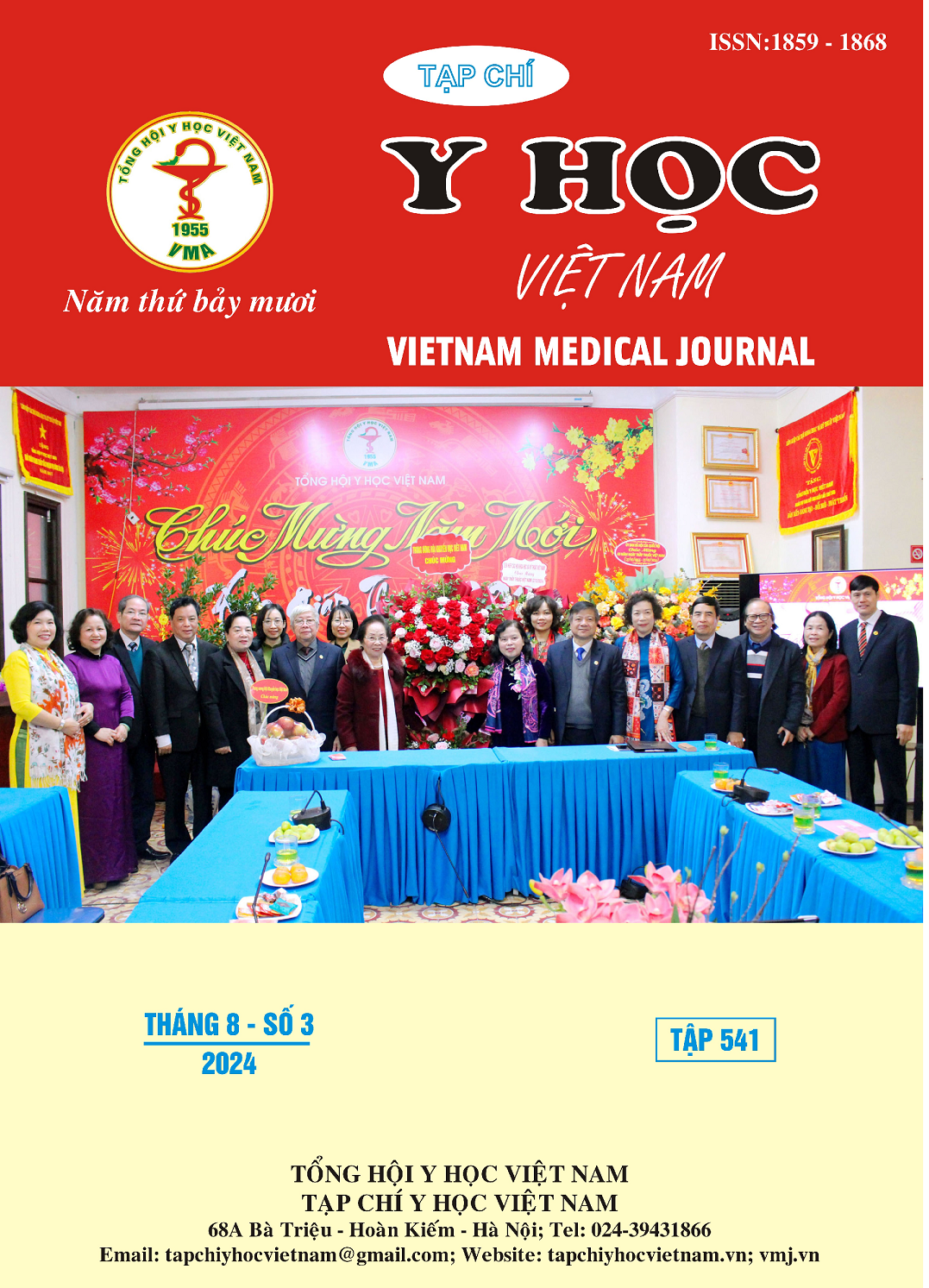RESULTS OF TREATMENT BOTH BONE DIAPHYSEAL FOREARM FRACTURES IN CHILDREN BY CLOSE REDUCTION AND PERCUTANEOUS ELASTIC INTRAMEDULLARY NAILING ON FLUOROSCOPY
Main Article Content
Abstract
Introduction: Both bone forearm fractures are common orthopedic injuries in fractures, accounting for about 40% of injuries in children. The most popular management for these fractures is closed reduction associating with percutaneous insertion of elastic intramedullary nail on fluoroscopy. Objective: Evaluation of the results treatment both bone diphyaseal fractures in children by closed reduction and percutaneous insertion of elastic intramedullary nailing on fluoroscopy. Subjects and Methods: This is a descriptive study of 86 patients (from 4 to 16 years old) with both bone diphyaseal fractures in children by closed reduction and percutaneous insertion of elastic intramedullary nailing on fluoroscopy at Dong Anh genaral hospital between January 2020 to March 2024. Results: Mean age: 12.8 ±2.3 (4-16), mainly 11-16 years old (60.5%) and 63.9% of the patients were males. Traffic accidents and daily–life accidents account for the highest percentage of injuries with 81,4%. According to the AO classification, the A class is 40,7%, the B class is 44,2% and the C class is 15,1%. Closed reduction successful in 96.5%, 3.5% of cases were failed to align by closed reduction and had to undergo open fixation. Nails used for one bone ≥ 2 accounted for 97.7% and using 1 nail for one bone accounted for 2.3%. 81.4% of cases took less than 45 minutes in operation room (OR). 45 – 60 minutes: 11.7% and > 60 minutes: 6.9%. Post – operative X-ray, the anatomic results of post-operation were 83.7% non-displaced, 15.1% less displaced and 1.2% highly displaced. No secondary displacement was recorded, 3 case superficial infection. Union was achieved in 100% subjects. The outcomes were anatomically and functionally evaluated rating system, 80 patients (93%) were excellent and good and none had unacceptable results. Conclusions: Closed reduction associating with percutaneous insertion of multiple elastic intramedullary nail is a nonviolent method of treatment for both-bone diaphyseal forearm fractures with large displacement in children. Use of this treatment results in predictable good results in both anatomical and functional acceptance. It also illustrates low complication rates and remarkable healing outcomes fix the fracture firmly, create conditions for early rehabilitation after surgery and bring good results to the patient.
Article Details
Keywords
children’s both-bone forearm fractures, closed reduction, elastic intramedullary nail.
References
2. Pogorelić Z, Gulin M, Jukić M, et al (2020). Elastic stable intramedullary nailing for treatment of pediatric forearm fractures: A 15-year single centre retrospective study of 173 cases. Acta Orthop Traumatol Turc; 54(4): 378-84.
3. Caruso.G, Caldari.E., Sturla. F. D, et al. (2021). Management of pediatric forearm fractures: what is the best therapeutic choice? A narrative review of the literature. Musculoskeletal Surgery; 105:225–234
4. Nguyễn Đắc Nghĩa, Nguyễn Đức Bình (2012). Tăng cường khả năng chống xoay cho chùm đinh nội tủy cố định gãy thân xương cẳng tay. Tạp chí Y học Việt Nam: (2), 35-39.
5. Keith R. R, David S. F, Daniel W. G, et al (2008). Comparison of intramedullary nailing to plating for both-bone forearm fractures in older children. J Pediatr Orthop; 28(4): 403-409.
6. Nguyễn Thanh Long, Nguyễn Thành Tấn, Nguyễn Quang Tiến (2018). Đánh giá kết quả điều trị gãy kín thân hai xương cẳng tay ở trẻ em bằng phương pháp nắn kín xuyên đinh Kirschner qua da dưới màn tăng sáng tại bệnh viện Nhi Đồng Cần Thơ năm 2017-2018. Tạp chí y dược học Cần Thơ; (16): 1-7.
7. Mansoor A.T, Imtiyaz H.D, Shafeeq A.S, et al (2019). Evaluation of the functional results of intramedullary nailing in diaphyseal both bone forearm fractures in children. International Journal of Orthopaedics Sciences; 5(3): 288-293.
8. Tarun K.S, Hariprasad S, Vinod K.K, et al. (2023). Evaluation of the functional outcome of both bone forearm fractures in the Pediatric population with the titanium elastic nailing system in a tertiary care center. Cureus 15(5): 1-7.
9. Frideriki P , Dimitrios M, Christos K, et al (2020). Flexible intramedullary nailing in the treatment of forearm fractures in children and adolescents, a systematic review. Journal of Orthopaedics; 20: 125–130


